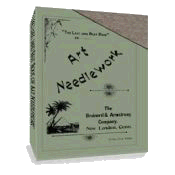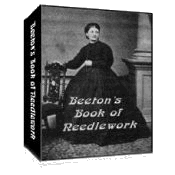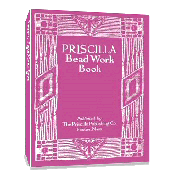The Kensington Stitch
Also Known as "Solid Embroidery"
Uses of the Kensington Stitch
The Kensington stitch is also appropriate for embellishing garments. It is especially beautiful on dresses, wrappers, jackets, etc. When using this stitch on dress collars, vest fronts, etc, the material should be first stiffened by backing it with crinoline, as they did in years past, or with modern day materials sold in your local fabric store for this very purpose.
A little Kensington Stitch History
The Kensington Stitch is an old stitch, used for centuries past, and derives its name from its resemblance to the plumage of a bird, in its smoothly overlapping effect and its soft graduation of shades. It’s original name was opus plumarium,which means plumage or feather work. The stitch was revived by the Kensington School of Art Embroidery, and given the name "Kensington Stitch" by which it is now so widely known.
Over the last 120 years, the Kensington stitch has been described in different ways. Some books state that the Kensington stitch is another name for the “Feather Stitch” while others state the Kensington stitch is really just the repetition of the Long and Short Stitch.
Instructions and Illustrations for the Kensington Stitch
Whether you regard it as variations of the Feather Stitch or the Long and Short Stitch, the result will be the same. The following information was taken from a book written in 1899. Here the Kensington stitch is described as the Long and Short Stitch working in conjunction with the Feather Stitch.
Simple Long and Short Stitch
This stitch is the first step and is well described by its name. The method is one long and one alternate short stitch laid side by side on the surface. Having our linen centerpiece or doily “drum tight” in a frame or hoop, these stitches should be commenced on the outline or edge of the design which they are intended to define, and carried through the linen within the form, leaf, or petal. The points of especial care in this work should be to make the outline or edge perfectly true and unbroken, and to see to it that the stitches laid side by side form a smooth surface. In order to succeed in the first essential, the needle must be brought up every time in exactly the right place, which is a shade beyond the stamped line. If the stitches are taken through the stamped line itself or a shade within it, the stamping will show. Nothing could be more undesirable than this.
While every other stitch should be long and every other one should be short, all the long stitches should not be the same length, nor all the short ones. They should vary in themselves.
The length of the stitches must be determined by the size of the leaf or petal they are to border. When the petals are very small they are likely to cover the larger part of it; if they are from one to three inches about one third will be covered. This rule must, however, be held in a very tentative way indeed, as the possible variety of form suggests so many exceptions as to make it almost impossible to make a definite statement as to the length of stitches. A proper proportion to the size of the form should be the guide, with the reassuring fact in mind that if the stitches are correctly placed they may be from ¾ of an inch to an inch long and still lie well. The illustrations below show clearly the method of the long and short stitch.


Feather Stitch or Solid Embroidery
The Long and Short stitch is the first step in this, the most beautiful of embroidery stitches. When the long and short stitches have been carried around a form or petal, or over one section of it, layover this row another series of stitches “long and short”, placed exactly in the same direction as the first, and covering the first about two thirds its width. See Fig. I b (1).
It will seem to the amateur an extravagance of time and material to cover these rows so fully one over the other, but it is just this point which is the way to beauty in the work: it raises the surface slightly and makes it very rich. Besides, one row blends with the next because the alternating long and short stitches of the over row allow very little of the preceding to show. They appear only because of the difference in length of the upper edge of the covering row. Commence the first stitch of the second layer by bringing up the needle about one sixteenth of an inch below the first stitch of the first row, between it and the second stitch of the first row, send it down about one fourth inch below the finish of the first stitch of the first row. Take the next stitch, which will be a short one, in the same way in regard to its relation to the first row. Continue these stitches, thus forming a second row over the first, covering it at least two thirds its length. The first row is of course perfectly even on its upper edge, that is, it coincides with the stamped outline, but the second row is necessarily long and short on both edges, as it is worked over the first. Fig. I b (2) shows this — second row in detail, unrelated to the first.

This illustration will make plain what is meant by “long and short” on both edges. In this way one shade is made to blend into the next, not gradually so that the stitches are invisible, but in such a way as to produce a strong and clear effect. This is embroidery and not an imitation of painting. Continue these rows until they cover the form; the length of the stitches should be determined by the size of the form to be embroidered. The last row must of course conform to the design as it is finished off, as must all stitches wherever they come in contact with the outline. See Fig. I b (3).

Overlap Long and Short Stitch.
The first stitch in this process on a line is taken by bringing the needle out on the line at its start; send the needle down on the right side of the line, forming, when the thread is drawn through, a stitch about half an inch long; take the next stitch on the line slightly in advance of the start of the first; draw through the thread and send the needle down on the line a trifle above the finish of the first stitch, but crossing it; — see Fig. I c (l) — take the succeeding stitches in the same way, making each one cross the end of the one before it.
This work forms a raised ridge. The series of stitches lapping each other may be carried around circles with good effect. This is an especially pretty way to embroider tendrils. See Fig. I c (2).

Return to top of Kensington Stitch page.



 433 pages!
433 pages!

